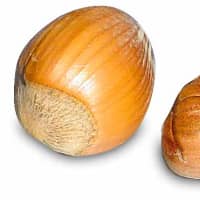Hazelnut
Healing Properties
- Antioxidant:
- Cytoprotective: protects cells against harmful agents.
- The Asian hazelnut, Corylus heterophylla Fisch–a species of hazel native to eastern Asia in northern and central China, Korea, Japan, and southeastern Siberia–exhibited strong antioxidant and cytoprotective effects.[1]
- Endothelial Health: inhibits the production of ROS synthesis in human vein endothelial cells.[1:1]
- Weight Loss: The addition of Turkish hazelnuts to a high fat diet was associated with a decrease in body weight, food consumption, and lipid peroxidation levels.
- Heart Health: (Cardiovascular Health) The addition of hazelnuts (especially Turkish) to a high fat diet was associated with a decrease in atherogenic index (formation of fatty plaques in the arteries).
- Hepatoprotective: (Hepatoprotection or antihepatotoxicity) prevents liver injury due to high fat diet.[2]
Disease / Symptom Treatment
- Obesity:
- Heart Disease: (Cardiovascular Disease)
- Dysmetabolic syndrome: A constellation of metabolic abnormalities in serum or plasma insulin/glucose level ratios, lipids (triglycerides, LDL cholesterol subtypes and/or HDL cholesterol), uric acid levels, coagulation factor imbalances and vascular physiology.
Title: Cytoprotective effect and purification of novel antioxidant peptides from hazelnut (C. heterophylla Fisch) protein hydrolysates
Author(s): Chunlei Liu, Dayong Ren, Jingjing Li, Li Fang, Ji Wang, Jingsheng Liu, Weihong Min
Institution(s): College of Food Science and Engineering, Jilin Agricultural University, Changchun 130118, PR China National Engineering Laboratory of Wheat and Corn Deep Processing, Changchun 130118, PR China
Publication: Journal of Functional Foods
Abstract: In the present study, antioxidant fraction (C2) has been obtained from a hazelnut processing by-product. The C2 exhibited strong antioxidant and cytoprotective effect against Ang II induced oxidant injury via up-regulation of SOD and heme oxygenase-1 (HO-1) levels and down-regulation of xanthine oxidase-1 (XO-1) level to inhibit the production of ROS synthesis in human umbilical vein endothelial cells (HUVECs). LC-ESI-MS/MS results revealed that C2 was found to include six novel peptides and their amino acid sequences were ADGF (408.16 Da), AGGF (350.16 Da), AWDPE (616.25 Da), DWDPK (659.29 Da), ETTL (462.23 Da), and SGAF (380.17 Da). All six synthetic peptides showed excellent antioxidant activity. Especially, the ADGF peptide exhibited the highest ABTS radical scavenging activity and DPPH radical scavenging ability among them. Therefore, the peptides isolated from wild hazelnut protein hydrolysates may be used as potential antioxidants in the food and drug industries.
Link: https://doi.org/10.1016/j.jff.2017.12.003
Citations: ↩︎ ↩︎Title: Nutraceutical potential of Corylus avellana daily supplements for obesity and related dysmetabolism
Author(s): Adriano Mollica, Gokhan Zengin, Azzurra Stefanucci, Claudio Ferrante, Luigi Menghini, Giustino Orlando, Luigi Brunetti, Marcello Locatelli, Marilisa Pia Dimmito, Ettore Novellino
Institution(s): Department of Pharmacy, University “G. d’Annunzio” of Chieti-Pescara, Via dei Vestini 31, 66100 Chieti, Italy; Department of Biology, Science Faculty, Selcuk University, Konya, Turkey; Department of Pharmacy, University “Federico II” of Naples, Via D. Montesano, Italy; Department of Pharmacology, Ladoke Akintola University of Technology, Osogbo, Osun State, Nigeria; Department of Chemical Pathology, LAUTECH Teaching Hospital, Osogbo, Osun State, Nigeria; Department of Anatomy, Ladoke Akintola University of Technology, Osogbo, Osun State, Nigeria
Publication: Journal of Functional Foods
**Date:**August 2018
Abstract: In this study, the nutraceutical potential of two hazelnut varieties (Turkey and Italy) were examined by studying several aspects including the phytochemical properties, antioxidant potential, cell viability and ex vivo neuroprotective potential. Results showed that the Turkish hazelnut had the higher concentration of phenolic acids, flavonoids, higher antioxidant capacity and enzyme inhibition properties and lower saturated fatty acid concentration than the Italian sample. The in vivo studies showed that compared to the Italian hazelnuts, the addition of Turkish hazelnuts to high fat diet was associated with a more significant decrease in body weight, food consumption, atherogenic index, lipid peroxidation levels and biochemical/morphological markers of liver injury. Also, from our results, the two hazelnut varieties were protective against β-amyloid-induced neurochemical changes and high-fat diet induced alteration of metabolic indices.
Link: https://doi.org/10.1016/j.jff.2018.06.016
Citations: ↩︎
